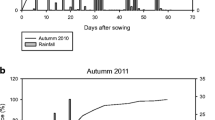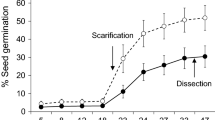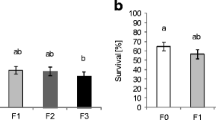Abstract
The effect of established populations of two sympatric annual weeds,Galinsoga ciliata (Raf) Blake andG. parviflora Cav on their newly emerged seedling cohorts was studied. These weeds occur abundantly in croplands and early successional communities in the northeastern hill region of India. Seed germination, survivorship and growth in both cases were reduced owing to competition from their established plants. The established cohorts ofG. ciliata exercised greater suppressive effect than those of G. parviflora. Twenty five-day old cohort ofG. ciliata caused maximum suppression on foliage production, seed output and dry matter yield of the newly emerged individuals ofG. parviflora.
Similar content being viewed by others
References
Babu C R 1969Galinsoga ciliata (Raf) Blake (Asteraceae)—a species new to India;Bull. Bot. Surv. India 11 184–185
Chippindale H G 1948 Resistance to inanition in grass seedlings;Nature (London) 161 65
Friedman J 1971 The effect of competition by adultZygophyllum dumosum Bioss, on seedlings ofArtemisia herba-alba Asso. in the Negev desert of Israel;J. Ecol. 59 775–782
Gupta G P and Tripathi R S 1979 Competition betweenBothriochloa pertusa (L.) A. Camus andDichanthium annulatum (Forsk) Stapf as modified by their time of emergence in mixture;Trop. Ecol. 20 147–154
Harper J L, Williams J T and Sagar G R 1965 The behaviour of seeds in soil I. The heterogeneity of soil surfaces and its role in determining the establishment of plants from seeds.J. Ecol. 53 273–286
Pemadasa M A and Amarasinghe L 1982 The ecology of montane grassland in Sri Lanka V. Interference in populations of four major grasses;J. Ecol. 70 731–744
Putwain P D and Harper J L 1970 Studies in the dynamics of plant population III. The influence of associated species on populations ofRumex acetosa L. andR. acetosella L in grassland;J. Ecol. 58 251–264
Rai J P N and Tripathi R S 1983 Population regulation ofGalinsoga ciliata andG. parviflora: Effect of sowing pattern, population density and soil moisture and texture;Weed Res. 23 151–163
Rai J P N and Tripathi R S 1984 Population dynamics of different seedling cohorts of two co-existing annual weeds,Galinsoga ciliata andG. parviflora, on two contrasting sites;Acta Oecol.—Oecol. Plant 5 357–368
Singh A 1980Studies on population dynamics of Eupatorium odoratum L.,E. adenophorum Spreng.and E. riparium Regel; Ph.D. Thesis, North-Eastern Hill University, Shillong, India
Tamm C O 1956 Further observations on the survival and flowering of some perennial herbs;Oikos 7 273–292
Usami Y 1976 Ecological studies on weeds in mulberry fields 2. Autecology ofGalinsoga parviflora Cav.Weed Res. Jpn 21 76–80
Yadav A S and Tripathi R S 1983 The populations of transplanted seedlings ofEupatorium adenophorum andE. riparium as regulated by their adult plants;Trop. Ecol. 24 201–215
Author information
Authors and Affiliations
Rights and permissions
About this article
Cite this article
Rai, J.P.N., Tripathi, R.S. Effect of established populations of two annual weeds on their newly emerged seedling cohorts. Proc. Indian Acad. Sci. 95, 79–86 (1985). https://doi.org/10.1007/BF03053122
Received:
Revised:
Issue Date:
DOI: https://doi.org/10.1007/BF03053122




